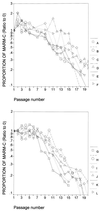Contingent neutrality in competing viral populations
- PMID: 11462003
- PMCID: PMC114966
- DOI: 10.1128/JVI.75.16.7315-7320.2001
Contingent neutrality in competing viral populations
Abstract
The replicative fitness of a genetically marked (MARM-C) population of vesicular stomatitis virus was examined in competition assays in BHK-21 cells. In standard fitness assays involving up to eight competition passages of the mixed populations, MARM-C competes equally with the wild type (wt), but very prolonged competitions always led to the wt gaining dominance over MARM-C in a very slowed, nonlinear manner (J. Quer et al., J. Mol. Biol. 264:465-471, 1996). In the present study we show that a number of quite unrelated environmental perturbations, which decreased virus replication during competitions, all led to an accelerated dominance of the wt over MARM-C. These perturbations were (i) the presence of added (or endogenously generated) defective interfering particles, (ii) the presence of the chemical mutagen 5-fluorouracil (5-FU), or (iii) an increase in temperature to 40.5 degrees C. Thus, the "neutral fitness" of the MARM-C population is contingent. We have determined the entire genomic consensus sequence of MARM-C and have identified only six mutations. Clearly, some or all of these mutations allowed the MARM-C quasispecies population to compete equally with wt in a defined constant host environment, but the period of neutrality was shortened when the environment was perturbed during competitions. Interestingly, when four passages of each population were carried out independently in the presence of 5-FU (but in the absence of competition), no significant differences were detected in the fitness changes of wt and MARM-C, nor was there a difference in their subsequent abilities to compete with each other in a standard fitness assay. We propose a model for this contingent neutrality. The conditions employed to generate the MARM-C quasispecies population selected a small number of mutations in the consensus sequence. It appears that the MARM-C quasispecies population has moved into a segment of sequence space in which the average fitness value is neutral but, under environmental stress, beneficial mutations cannot be generated rapidly enough to compete with those being generated concurrently by competing wt virus quasispecies populations.
Figures




Similar articles
-
Reproducible nonlinear population dynamics and critical points during replicative competitions of RNA virus quasispecies.J Mol Biol. 1996 Dec 6;264(3):465-71. doi: 10.1006/jmbi.1996.0654. J Mol Biol. 1996. PMID: 8969298
-
Density-dependent selection in vesicular stomatitis virus.J Virol. 2004 Jun;78(11):5799-804. doi: 10.1128/JVI.78.11.5799-5804.2004. J Virol. 2004. PMID: 15140977 Free PMC article.
-
Fitness analyses of vesicular stomatitis strains with rearranged genomes reveal replicative disadvantages.J Virol. 2004 Sep;78(18):9837-41. doi: 10.1128/JVI.78.18.9837-9841.2004. J Virol. 2004. PMID: 15331718 Free PMC article.
-
Contributions of vesicular stomatitis virus to the understanding of RNA virus evolution.Curr Opin Microbiol. 2003 Aug;6(4):399-405. doi: 10.1016/s1369-5274(03)00084-5. Curr Opin Microbiol. 2003. PMID: 12941412 Review.
-
Vesicular stomatitis.Vet J. 1999 May;157(3):239-60. doi: 10.1053/tvjl.1998.0303. Vet J. 1999. PMID: 10328837 Review.
Cited by
-
Modeling viral genome fitness evolution associated with serial bottleneck events: evidence of stationary states of fitness.J Virol. 2002 Sep;76(17):8675-81. doi: 10.1128/jvi.76.17.8675-8681.2002. J Virol. 2002. PMID: 12163587 Free PMC article.
-
Growth of an RNA virus in single cells reveals a broad fitness distribution.Virology. 2009 Mar 1;385(1):39-46. doi: 10.1016/j.virol.2008.10.031. Epub 2008 Dec 13. Virology. 2009. PMID: 19070881 Free PMC article.
-
Quasispecies theory and the behavior of RNA viruses.PLoS Pathog. 2010 Jul 22;6(7):e1001005. doi: 10.1371/journal.ppat.1001005. PLoS Pathog. 2010. PMID: 20661479 Free PMC article. Review.
-
Specific and nonspecific host adaptation during arboviral experimental evolution.J Mol Microbiol Biotechnol. 2011;21(1-2):71-81. doi: 10.1159/000332752. Epub 2012 Jan 13. J Mol Microbiol Biotechnol. 2011. PMID: 22248544 Free PMC article. Review.
-
Mutagenesis versus inhibition in the efficiency of extinction of foot-and-mouth disease virus.J Virol. 2003 Jun;77(12):7131-8. doi: 10.1128/jvi.77.12.7131-7138.2003. J Virol. 2003. PMID: 12768034 Free PMC article.
References
-
- Archer R H, Dykes C, Gerondelis P, Lloyd A, Fay P, Reichman R C, Bambara R A, Demeter L M. Mutants of human immunodeficiency virus type 1 (HIV-1) reverse transcriptase resistant to nonnucleoside reverse transcriptase inhibitors demonstrate altered rates of RNase H cleavage that correlate with HIV-1 replication fitness in cell culture. J Virol. 2000;74:8390–8401. - PMC - PubMed
-
- Berkhout B. HIV-1 evolution under pressure of protease inhibitors: climbing the stairs of viral fitness. J Biomed Sci. 1999;6:298–305. - PubMed
Publication types
MeSH terms
Grants and funding
LinkOut - more resources
Full Text Sources

